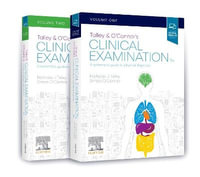
Epidemiology Kept Simple
An Introduction to Traditional and Modern Epidemiology
By: B. Burt Gerstman
Paperback | 5 April 2013 | Edition Number 3
At a Glance
480 Pages
Revised
24.1 x 17.22 x 2.42
Paperback
RRP $111.95
$70.90
37%OFF
or 4 interest-free payments of $17.73 with
orAims to ship in 7 to 10 business days
Epidemiology Kept Simple introduces the epidemiological principles and methods that are increasingly important in the practice of medicine and public health. With minimum use of technical language it fully explains terminology, concepts, and techniques associated with traditional and modern epidemiology. Topics include disease causality, epidemiologic measures, descriptive epidemiology, study design, clinical and primary prevention trials, observational cohort studies, case-control studies, and the consideration of random and systematic error in studies of causal factors. Chapters on the infectious disease process, outbreak investigation, and screening for disease are also included. The latter chapters introduce more advanced biostatistical and epidemiologic techniques, such as survival analysis, Mantel-Haenszel techniques, and tests for interaction.
This third edition addresses all the requirements of the
American Schools of Public Health (ASPH) Epidemiological
Competencies, and provides enhanced clarity and
readability on this difficult subject. Updated with new practical
exercises, case studies and real world examples, this title helps
you develop the necessary tools to interpret epidemiological data
and prepare for board exams, and now also includes review questions
at the end of each chapter.
Epidemiology Kept Simple continues to provide an introductory guide to the use of epidemiological methods for graduate and undergraduate students studying public health, health education and nursing, and for all practicing health professionals seeking professional development.
Industry Reviews
"This edition does a good job of updating the previous editions, which have not covered the ASPH epidemiology competencies." (Doody?s, 21 February 2014)
Preface to the Third Edition xi
Preface to the First Edition xiii
Acknowledgments xv
1 Epidemiology Past and Present 1
1.1 Epidemiology and its uses 2
1.2 Evolving patterns of morbidity and mortality 5
1.3 Selected historical figures and events 8
1.4 Chapter summary 30
Review questions 31
References 32
2 Causal Concepts 36
2.1 Natural history of disease 36
2.2 Variability in the expression of disease 40
2.3 Causal models 41
2.4 Causal inference 48
Exercises 58
Review questions 61
References 63
3 Epidemiologic Measures 66
3.1 Measures of disease frequency 67
3.2 Measures of association 74
3.3 Measures of potential impact 79
3.4 Rate adjustment 82
Exercises 90
Review questions 98
References 99
Addendum: additional mathematical details 101
4 Descriptive Epidemiology 104
4.1 Introduction 104
4.2 Epidemiologic variables 108
4.3 Ecological correlations 116
Exercises 121
Review questions 123
References 124
5 Introduction to Epidemiologic Study Design 126
5.1 Etiologic research 126
5.2 Ethical conduct of studies involving human subjects 129
5.3 Selected study design elements 130
5.4 Common types of epidemiologic studies 137
Exercises 138
Review questions 140
References 141
6 Experimental Studies 142
6.1 Introduction 142
6.2 Historical perspective 144
6.3 General concepts 146
6.4 Data analysis 152
Exercises 156
Review questions 157
References 157
7 Observational Cohort Studies 159
7.1 Introduction 159
7.2 Historical perspective 161
7.3 Assembling and following a cohort 163
7.4 Prospective, retrospective, and ambidirectional cohorts 164
7.5 Addressing the potential for confounding 165
7.6 Data analysis 166
7.7 Historically important study: Wade Hampton Frost’s birth cohorts 170
Exercises 174
Review questions 177
References 177
8 Case–Control Studies 180
8.1 Introduction 180
8.2 Identifying cases and controls 182
8.3 Obtaining information on exposure 185
8.4 Data analysis 186
8.5 Statistical justifications of case–control odds ratio as relative risks 193
Exercises 194
Review questions 198
References 199
9 Error in Epidemiologic Research 201
9.1 Introduction 201
9.2 Random error (imprecision) 203
9.3 Systematic error (bias) 209
Exercises 217
Review questions 219
References 220
10 Screening for Disease 222
10.1 Introduction 223
10.2 Reliability (agreement) 224
10.3 Validity 228
Summary 238
Exercises 239
Review questions 243
References 243
10.4 Chapter addendum (case study) 244
Further reading—screening for HIV 248
Further reading—general concepts of screening 248
Answers to case study: screening for antibodies to the human immunodeficiency virus 249
11 The Infectious Disease Process 255
11.1 The infectious disease process 255
11.2 Herd immunity 265
Exercises 267
Review questions 268
References 270
12 Outbreak Investigation 271
12.1 Background 272
12.2 CDC prescribed investigatory steps 273
Review questions 282
References 283
References—a drug–disease outbreak 286
13 Confidence Intervals and p-Values 302
13.1 Introduction 303
13.2 Confidence intervals 304
13.3 p-Values 312
13.4 Minimum Bayes factors 319
References 322
14 Mantel–Haenszel Methods 323
14.1 Ways to prevent confounding 323
14.2 Simpson’s paradox 325
14.3 Mantel–Haenszel methods for risk ratios 325
14.4 Mantel–Haenszel methods for other measures of association 329
Exercise 335
References 335
15 Statistical Interaction: Effect Measure Modification 337
15.1 Two types of interaction 337
15.2 Chi-square test for statistical 340
15.3 Strategy for stratified analysis 342
Exercises 344
References 345
16 Case Definitions and Disease Classification 347
16.1 Case definitions 347
16.2 International classification of disease 351
16.3 Artifactual fluctuations in reported rates 353
16.4 Summary 354
References 355
17 Survival Analysis 356
17.1 Introduction 356
17.2 Stratifying rates by follow-up time 359
17.3 Actuarial method of survival analysis 360
17.4 Kaplan–Meier method of survival analysis 362
17.5 Comparing the survival experience of two groups 364
Exercises 369
References 371
18 Current Life Tables 373
18.1 Introduction 373
18.2 Complete life table 374
18.3 Abridged life table 380
Exercises 383
References 384
19 Random Distribution of Cases in Time and Space 385
19.1 Introduction 385
19.2 The Poisson distribution 386
19.3 Goodness of fit of the Poisson distribution 390
19.4 Summary 394
Exercises 395
References 396
Answers to Exercises and Review Questions 398
Appendix 1: 95% Confidence Limits for Poisson Counts 434
Appendix 2: Tail Areas in the Standard Normal (Z) Distribution: Double These Areas for Two-Sided p-Values 436
Appendix 3: Right-Tail Areas in Chi-Square Distributions 439
Appendix 4: Case Study—Cigarette Smoking and Lung Cancer 441
Appendix 5: Case Study—Tampons and Toxic Shock Syndrome 448
Index 455
ISBN: 9781444336085
ISBN-10: 1444336088
Published: 5th April 2013
Format: Paperback
Language: English
Number of Pages: 480
Audience: Professional and Scholarly
Publisher: John Wiley & Sons (UK)
Country of Publication: US
Edition Number: 3
Edition Type: Revised
Dimensions (cm): 24.1 x 17.22 x 2.42
Weight (kg): 0.73
Shipping
| Standard Shipping | Express Shipping | |
|---|---|---|
| Metro postcodes: | $9.99 | $14.95 |
| Regional postcodes: | $9.99 | $14.95 |
| Rural postcodes: | $9.99 | $14.95 |
How to return your order
At Booktopia, we offer hassle-free returns in accordance with our returns policy. If you wish to return an item, please get in touch with Booktopia Customer Care.
Additional postage charges may be applicable.
Defective items
If there is a problem with any of the items received for your order then the Booktopia Customer Care team is ready to assist you.
For more info please visit our Help Centre.
You Can Find This Book In

Taking Charge of Adult ADHD: 2 Edition
Proven Strategies to Succeed at Work, at Home, and in Relationships
Paperback
RRP $51.99
$42.95
OFF

The Mindful Self-Compassion Workbook
A Proven Way to Accept Yourself, Build Inner Strength, and Thrive
Paperback
RRP $59.99
$39.25
OFF

SIGNED COPY
Paperback
RRP $36.99
$33.25
OFF




















